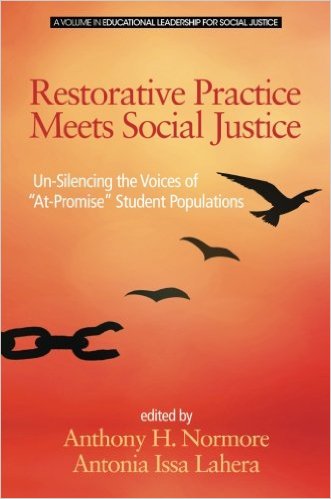 In his foreword to a new book, Restorative Practice Meets Social Justice: Un-silencing the Voices of “At-Promise” Student Populations (Normore & Lahera, 2017), the IIRP's second president John W. Bailie, Ph.D., argues that we need to restore the alignment of education philosophy and practice to a basic human blueprint for how we're hardwired to connect.
In his foreword to a new book, Restorative Practice Meets Social Justice: Un-silencing the Voices of “At-Promise” Student Populations (Normore & Lahera, 2017), the IIRP's second president John W. Bailie, Ph.D., argues that we need to restore the alignment of education philosophy and practice to a basic human blueprint for how we're hardwired to connect.
I’ve come to believe that the things that are most true in life are very simple and easy to understand. They are simply hard to consistently put into practice. The basic truths of human relationships are the same today as they were 20, 200, or even 2000 years ago. We want to live with dignity and respect. We all crave belonging and community. We want to be loved, heard, known and understood by those around us. We want the freedom to explore, create and take personal risks. And we want the certainty that there are at least a few people in our lives likely to catch us if we fall. At an intuitive level, we know that how we are treated is more important than whether or not we get the outcomes we want.
These things are true because they are hardwired into the human person. Humanity, at its imperfect-able best, has a shape and form that is instantly recognizable across the globe - regardless of culture, race, gender, age or other difference. For a moment, imagine that this human hardwiring is a rowboat on a lake. Like any common rowboat, the front is wedge-like, pointy, and upswept. The back is flat and square. The boat was made as a means to cross the lake. Now, you could row the boat flat side first. You could somehow push it sideways. You could sink the boat and drag it across the bottom. You might even take it apart and try to swim the pieces to the other side of the lake. But all of these innumerable possible options would create unnecessary complications, turbulence and resistance. Some of the options might even ultimately destroy the boat. However, if you respect the actual form of the boat as it is, you can glide with great stability and the least amount of effort. The shape of the boat, like that of the human person, matters.
The new social science of restorative practices is exploring an incredibly fascinating, and transformative idea – that there is an innate blueprint, common to the entire human family, for how we are hardwired to relate to one another. If there is even a small measure of truth in that claim (and global research increasingly demonstrates that there is a large measure of truth to that claim), then the implications for human society, education reformers and social justice advocates are immense.
As in the case of our rowboat example above, organizations, systems, or societies not aligned with this blueprint, will always cause dysfunction and harm to individuals, families and communities. They will be experienced as "unjust". And people will sense the wrongness of these systems – even if they cannot quite describe the why of it. If only subconsciously, humans know that authoritarian, paternalistic, or increasingly inhuman technocratic approaches to society do not feel right – even if they get results in some fashion or meet our material needs. This experience of injustice is likely to be felt most acutely by those on the margins of our communities – the poor, people of color, children, and those with cognitive, behavioral or emotional struggles.
Typically, when professionals and system representatives discuss reform, there is often an unspoken assumption that the system itself is basically sound and that only small targeted groups of individuals are really struggling. The related assumption is of course that everyone else is basically, contented, happy and successful. We see this bias in social services, organizational management, urban policy and clearly in the field of K-12 education. But what if the particular challenges that “at-promise” students present are not theirs alone? What if these young people are simply the most obvious manifestation of dysfunction caused in large part by a system that is increasingly failing to meet the common human relational needs of all learners? If so, what if there was an explicit framework to restore the alignment of education philosophy and practice to this basic human blueprint? The pages ahead will provide the reader with concrete examples of what that framework looks like in action.
The many individual practices of restorative practices are not fundamentally important in and of themselves. Practices and processes vary by culture, needs and taste. These practices are only truly important, or valuable, to the extent that they make our many human communities more meaningful, respectful, dignified and just. Restorative practices do not simply provide a convenient means to desired social outcomes. They provide a clear blueprint to ensure that on the path to making social justice, we model that justness in our own behavior – especially toward those people and systems we hope to change.

